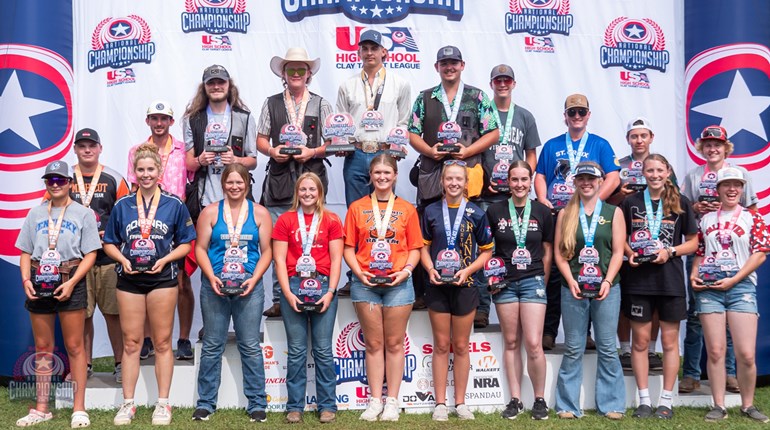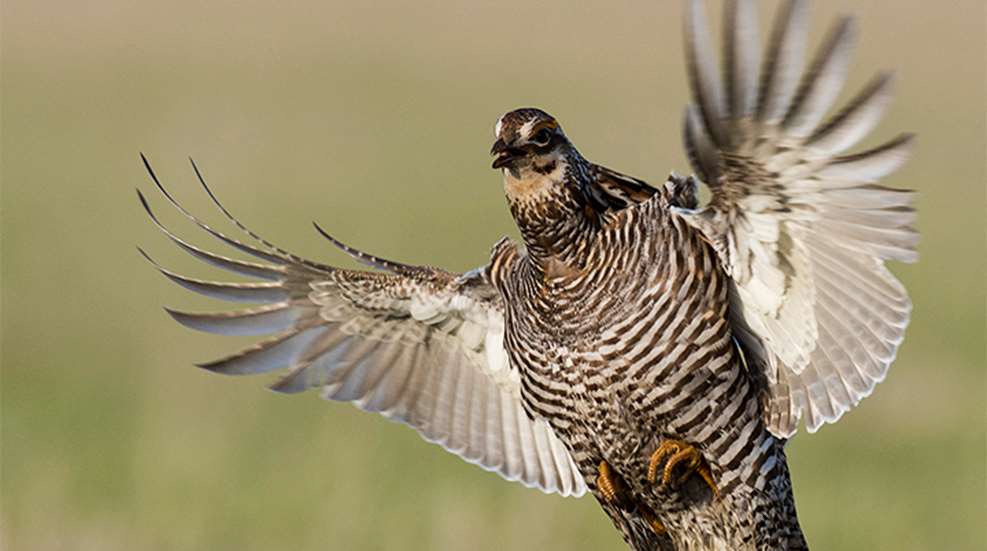
“Yoopers” are a different sort of folks. For those not familiar with the term, a Yooper is a person who lives on Michigan’s Upper Peninsula—that little slice of heaven neatly tucked away across a big bridge to the north of the main body of Michigan. I say “heaven” because along with the Yoopers, the U.P. also has some of the best ruffed grouse habitat, thus some of the best ruffed grouse hunting, in the United States.
As Yoopers go, Dennis Stachewicz, owner and operator of Aspen Thicket Grouse Dogs, might be a little more different than most. I quickly learned that last year after making the long trek from Oklahoma up to the U.P. to refamiliarize myself with the “king of game birds” after a nearly 25-year hiatus from the northern grouse woods.
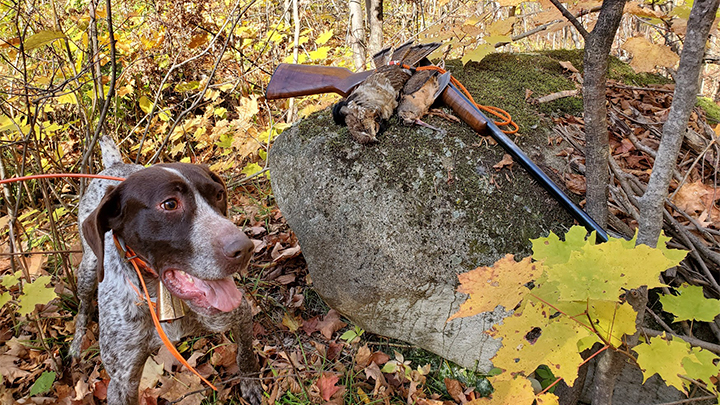
If you want to learn about grouse hunting throughout their range, few people know more about it—or are better able to explain it—than Stachewicz. A retired Army tank driver, avid grouse hunter, first-rate pointing dog trainer and jack of all trades, he’s been hunting ruffed grouse for 37 years and raising grouse dogs for two decades.
What’s the Deal with the King?
As an avid quail hunter for half a century who has also killed my share of ring-necked pheasants and a number of other game birds, I’ve always been a little irked over the “king of the game birds” deal. Why not the bobwhite? “Gentleman Bob” is certainly a positive nickname but doesn’t have the ring of royalty the grouse receives.
Stachewicz was happy to provide his thoughts on the topic.
“I think they call the ruffed grouse the king of the game birds for a couple of reasons,” he said. “They are basically the same thing as a combination of a lot of other birds. They’ll run like a pheasant. They live in unforgiving country, much like a chukar. They’re just the ultimate combination because when you’re walking through that cover, it’s not easy. And they are hard as hell to shoot at through the trees. They’re one of our original species of birds. They’ve adapted over many, many years. They were here from day one, and they’ve evolved over time. And they will run.”
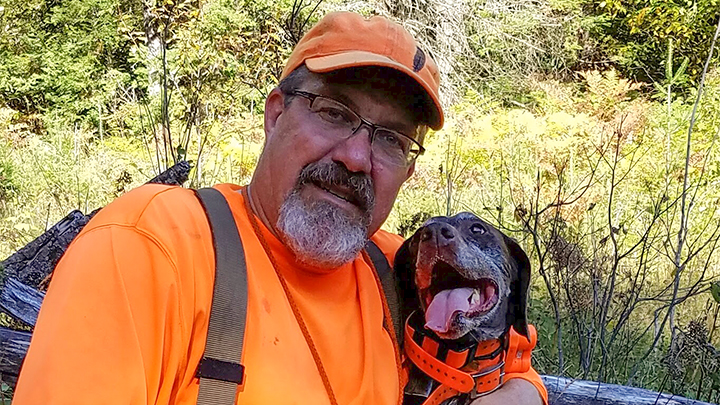
Stachewicz said there’s also a certain mystique about grouse hunting.
“The grouse hunter was always looked at like the muskie fisherman,” he said. “You’ve got to like a lot of misery to do either. It’s like the fish of 10,000 casts. It’s not like you can go and shoot a limit of grouse every day you go out. It’s hard work, but fun work.”
Make no mistake, Stachewicz has hunted plenty of other game birds throughout much of the country. But he always returns to his beloved grouse.
“I’ve taken my dogs out to Montana,” he said. “I’ve taken them to North Dakota. I’ve taken them to quail plantations down South. And by far the ruffed grouse is my favorite.
“That’s the whole reason I moved up to the U.P. When I was done with the Army and school, I decided to go live where I want to be and do what I want to do. And ruffed grouse is king for me.”
Dogs with Noses and Smarts
Hunting grouse with pointing dogs puts an extra level of enjoyment into the sport for bird dog lovers. For many, watching the dogs work is as much a part of the enjoyment as shooting a grouse or two.
Stachewicz grew up in the city where his family couldn’t keep a bird dog. As a youngster, he hunted areas of the northern U.P. dogless, but always knew something was missing.
“After I got out of the Army and got out of college, I told myself I was going to buy a dog,” he said. “I really didn’t know what kind I was going to get at the time. But I remembered that my grandfather had German shorthairs when I was very young and used to hunt. So, I thought, ‘If they’re good enough for my grandpa, they’re good enough for me.’ And I got a dog that I bought from an unplanned, accidental litter.”
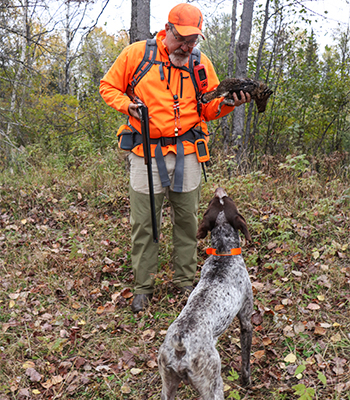
Unknowingly, Stachewicz had bought what turned out to be an outstanding grouse dog—one that even won a grouse dog trial at the trial grounds down farther south in Michigan. Once he’d experienced a great grouse dog, getting more was a natural next step.
“It just so happened that I was able to secure the services of his father and breed to a female I had got as my second dog,” he recalled. “And that was like the birth of Aspen Thicket Grouse Dogs. I kept a dog named Panzer out of that litter, and all he’s done his whole life is throw clones of himself. And in my opinion, he was better than the first dog.”
While Stachewicz prefers German shorthairs, many different breeds of dogs can perform well in the grouse woods. Many English setters and pointers do quite well hunting grouse, as do Brittanys. Even my field-bred Irish setters took to the grouse woods after a little bit of time becoming familiar with the terrain and cover. Regardless of breed, there are certain characteristics a dog needs to be considered a good grouse dog.
“There are a lot of different people who have a lot of different opinions about what makes a good grouse dog,” Stachewicz said. “I believe what makes a good grouse dog is a combination of a number of things. Number one, it has to have a top-notch nose. It has to have a ton of natural pointing instinct. Another really important ingredient is it has to be smart. That all comes into play in the grouse woods.”
Stachewicz said that unlike hunting Hungarian partridge on the North Dakota prairies or hunting Mearns quail in the deserts of New Mexico, a dog running through the grouse woods has to be able to filter out a lot more olfactory input.
“When you’re in the ruffed grouse woods, there are a lot of different scents,” he explained. “That dog has to sort through probably about 100-plus different types of scents in that environment alone. Whether it’s different types of trees, different types of detritus, mushrooms, bears, deer, rabbits, all kinds of things that inhabit the forest.
“Then it has to single out a grouse. Then it has to try to point that grouse for you. That grouse is going to relocate through a bunch of stuff, and the dog has to have the brains to be able to relocate that bird and reset it for you until you get up to that dog without damaging the goods—without flushing the bird on you.”
Hunting in thick grouse cover requires some specialized equipment since you won’t be able to see your dog 30 or 40 yards away, and your dog won’t be able to see you. A good whistle is a must for calling in your dog when he gets a little out of your comfort range.
For keeping track of your dog, the three main choices are old-fashioned bells, equally old-fashioned beeper collars or GPS technology. All three have their advantages and disadvantages.
GPS units can allow you to keep track of your dog at all times, but many are hard to read while walking along through thick cover. Bells are great for knowing where your dog is while moving, but since they stop ringing when the dog points you better keep tabs of their location all the time. Beepers are annoying, but they generally change their intensity when the dog points and allow you to know exactly where he or she is.
Stachewicz prefers a bell on the collar for most of his hunting because of the feedback it gives him concerning what the dog is doing at all times, plus GPS for locating the dog when it is on point.
“The bell tells me what the dog is doing,” he said. “Grouse run quite a bit. The bell tells you a lot about what’s going on with the interaction between the grouse and the dog. In the cover we hunt, you can’t always see the dog. That bell is actually kind of like your visual on the dog.
“If that bell stops and that dog goes on point, then the dog comes out hard again, that bird may be gone. But if the dog starts doing a little methodical creeping—relocate, point, creep, point—you know he’s tracking a bird and is trying to stay with it. It’s just like watching a dog when you can’t see it.”
Not All Grouse Cover is Equal
Fortunately for Stachewicz and other grouse hunters, there is a lot of land open to public hunting on the Upper Peninsula. In fact, about 95 percent of the land he hunts is open to the public. That, however, equates to hunting pressured birds as the season progresses, and finding them isn’t always easy.
“Understanding the pressure is an important part of it, but what are you going to do about it?” Stachewicz said. “There is no app, no super trick that can make it easy for you to figure out how to hunt pressured birds. That’s something that comes with experience—and I mean boots-on-the-ground experience. Because you have to find the secondary and tertiary level covers that those birds are going to go to. And sometimes they go to a secondary cover for escape, and then they’ll have another tertiary level of cover that’s going to be one that they can live in if they need to. They are generally in closer proximity to one another, but they could be up to a quarter-mile away from a spot that you would really want to hunt.”
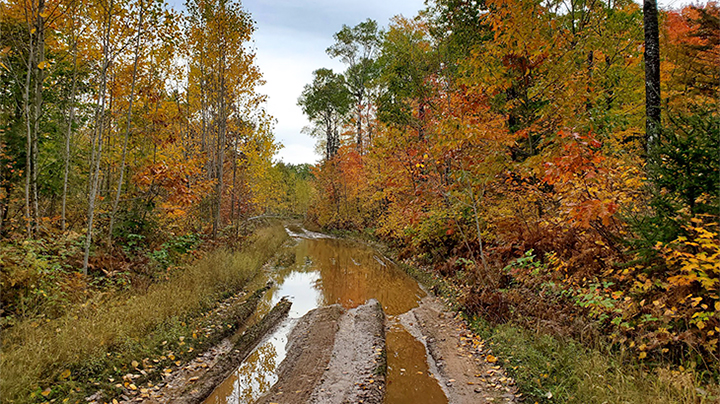
A good place to start is other locations that other hunters are likely to have overlooked, according to Stachewicz.
“The first thing I will do when ruffed grouse hunting, if there’s been a lot of pressure, I will immediately work the back side of the primary cover that the people are hunting,” he said. “So, if there is a couple-hundred-acre clear-cut that is in its prime, I won’t go in it. I’ll work the outside edge of it. If I move birds, I’ll follow them. But if I don’t move birds, then what I’ll do is break apart the adjacent habitat. Typically, I’ll look for something that’s a little bit thicker and a little bit wetter in my neck of the woods. Look for that wetter cover, because that’s typically where you’ll find the more secondary food types in our area—highbush cranberry and things along those lines.”
Pay attention when going through those adjacent areas, he said. You just might learn something that will lead to success—either then or in the future.
“I’ve had times when I’ve been adjacent to some maples and the next thing you know there is a bunch of grouse 100 to 150 yards into those old-growth maples, but underneath them,” he said. “There were a bunch of maple shoots coming up underneath about 4 or 5 feet tall. You find a bunch of grouse in there feeding on the maple spinners, and they’re not even pressured because nobody will walk through that. Nobody would even think about hunting that.”
In fact, Stachewicz said food can be the key to finding the birds. In years when there aren’t many acorns or highbush cranberries, the birds might be focusing more on greens. However, in years or in areas where there is lots of food available—acorns, cranberries, autumn olive, all the stuff grouse really love—it’s much harder to predict a pattern.
“When there’s a lot of food, they’ll be spread out,” Stachewicz said. “When there’s not, they’ll be concentrated. When the pressure pushes them out of the area, you’ve just got to figure out where they’re going based upon what they’re eating and what kind of hide position they have.”
In the end, finding grouse takes a lot of work. Those willing to put in the miles are much more likely to be successful than those who want to jump out of the truck and make a 200-yard circle through some likely looking cover, since many other hunters likely have already done that.
“We’re in this vast society that has to have immediate results,” Stachewicz said. “So, the long walk in the woods with your bird dog for three or four hours—half a day hunt—exploring a lot of stuff, that’s gone away. You have people who have smartphones with apps, they have their trip planned out and they have a specific place they want to hunt, and they run and gun it. They put a dog on the ground, they blow through it and if they don’t move any birds they go on to the next one.
“That’s their way of hunting. But if you’re not pushing deep and spending a lot of time with boots on the ground, you’re going to miss a lot of opportunities.”
It’s All in the Gun Mount
Shooting in the grouse woods is a different animal than shooting on the prairie or in the desert. The majority of grouse that flush on a typical hunt are heard more often than they are seen. And when they are seen, it’s typically just through “windows” in the cover as they fly away.
At the flush, you’ll usually be standing on unlevel ground, surrounded with thick brush. Often, getting the gun up is tough, and swinging it can be even tougher. Stachewicz said to be successful you have to remember the basics.
“Practice, practice, practice mounting the gun,” he said. “It’s all in mounting the gun, no matter how thick the cover. Cheek to stock, pull the trigger. It’s all muscle memory. A lot of us grouse hunters just practice cheek to stock and proper mounting of the gun, and the rest of it comes naturally.
“It’s snap shooting. It’s not shooting clays or anything like that. When you snap shoot at those grouse that are moving like that, the most important things are muscle memory, cheek to stock, boom.”
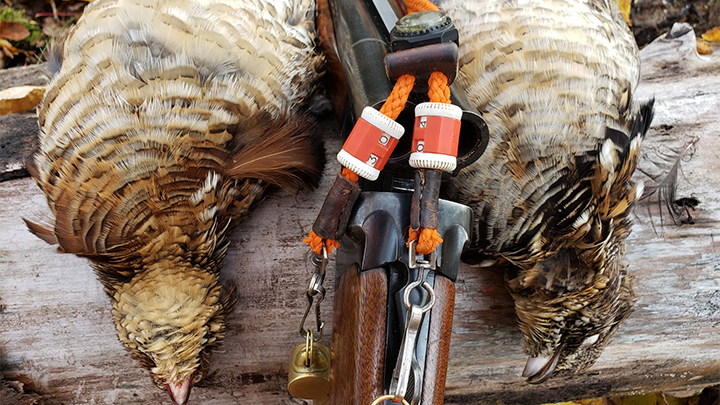
Stachewicz even practices shooting in somewhat simulated hunting conditions in the woods behind his house, preparing him better for when he’s in the grouse woods and a flushed bird is winging its way through the thick stuff.
“We go out back and set the mechanical target thrower up so we get a little bit of it going through the woods,” he said. “That helps you quite a bit because then you’re snap shooting the glimpse. That’s what you’ll be doing in the grouse woods.”
As far as guns and loads, Stachewicz favors a fairly short, 20-gauge side-by-side double-barrel—one that is light and will swing quickly—when heading to the grouse woods.
“I shoot ⅞ of an ounce of number 7½ shot,” he said. “Keep in mind I hunt over pointing dogs, so the majority of shots I’m going to get are relatively close. My first barrel is cylinder, and my second barrel is skeet 1.”
Dining with the King
You’ll likely look long and hard before you find another game bird that compares to the king at the dinner table.
“Compared to other game birds, the grouse is by far the best,” Stachewicz said. “It’s the best white meat God ever invented. It really is. It’s tender. It’s not very gamey. And it’s as clean and organic as you can get.”
While grouse can be deliciously prepared in a number of different ways (check out about any wild-game cookbook on the market), Stachewicz’s favorite way to cook the bird involves little more than a limit of grouse, a pound of butter, a little Bisquick and a pint of heavy whipping cream.
“Basically, you breast out the grouse, cut the breast in half, make some medallions out of it, roll it in some Bisquick and fry it in a pound of butter,” he said. “Once you get it browned, put in the pint of heavy whipping cream, bring it to a simmer and cover it for 20 minutes.
“And I serve it with biscuits. Even us Northern boys can have biscuits every now and then!”
While some kind of eye protection is recommended anytime hunting with a shotgun is involved, it’s particularly critical for grouse hunting. Many times, you’ll bust through thick stuff taller than your head, and it’s easy to get a limb in your eye if you don’t wear sunglasses or protective glasses at all times.
In many areas where ruffed grouse are found you’ll also find woodcock—sometimes referred to as timberdoodles—so often grouse hunts become mixed-bag hunts. These small migratory game birds about the size of a bobwhite quail frequent thick cover in many of the same areas that grouse do and are known for holding much better for pointing dogs.
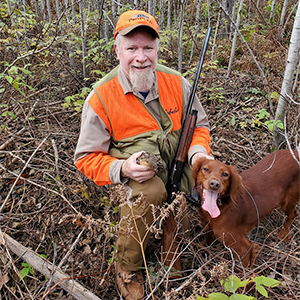
“You need to find the stuff that makes a noise when your boot walks in it," he says. "A good rule of thumb is that a quarter-inch of your boot is in the mud and it’s making a sopping noise.”












